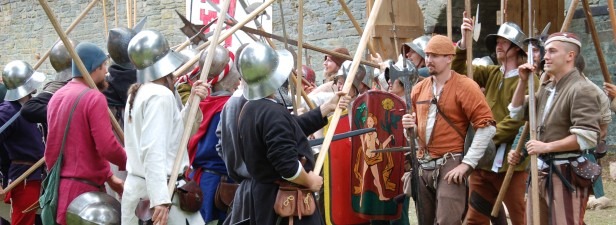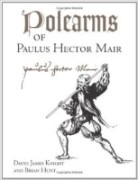“I shall now consider of Wounds with loss of Substance made by Bill, Pole-axe, etc., some cutting twice or thrice in one or near one place, whereby the Wound is large, traverse, yea and oblique….” – Surgeon R. Wiseman, circa 1676. [1]
Swords are the preferred weapon in modern Western Martial Arts (WMA), as they have been for most of our martial history. Venerated for their material strength, swiftness and sharp edges, blades are given names such as "Leg Biter" and passed from father to son.

Polearms, however, seem for the most part to be relegated to being thought of as "sticks" and staffs that were the weapons of the serf levies and forest outlaws… that is to say, blunt instruments of brute force only used by the working classes. This is a 21st-century misconception, and a gross one.
In their production Polearms of Paulus Hector Mair [2]; Knight and Hunt have worked to rectify this misunderstanding within the community and treat us to a much overdue, detailed and useful guide to the varied and imaginative use of a variety of renaissance polearms, including their counter-cavalry use by footmen in battle and their duelling applications for armoured knights in tournaments or judicial combat.
A Broad Overview
Paulus Hector Mair was a dedicated practitioner of the Liechtenauer style of renaissance martial arts, and was best known for being an outspoken advocate of the requirement to keep the martial tradition alive in subsequent generations. He collected a truly impressive library of past and contemporary WMA works and produced his own detailed compilation of martial arts instruction – his 1540 opus Ultimate Book of the Art of Athletics.
In recognition of its importance, Knight and Hunt have taken their favourite elements of Mair’s work, translated them (from two different languages), enhanced the original supporting illustrations, and ended up with an easy-to-read (if not to fully understand) authentic representation of the state of polearm combat as it was in the 16th Century.
Within the book itself, a brief biography of Mair is included, after which the authors devote one chapter each to a particular sub-category within the family of polearms weaponry.
And useful to both the fighting and scholarly elements within us, the book has a German Glossary in the back as well as the "literal" English translations of selected texts, a register of the diagrams and a bibliography that, less the language dictionaries, must have been a joy to peruse.
Chapter-by-Chapter
 Each weapons chapter begins with an illustration and a short description of the featured weapon. A few words as to its history, size, use, and applicable terminology are given. Within the chapter, each featured movement is contained within a two-page spread that includes the original Latin and German texts on the left and a "modern" English interpretation supported with a crisp diagram on the right. Weapon categories include the Spear and Shortstaff (the shortstaff being Mair’s "foundation for all the polearms later depicted"); Lance and Longstaff; Halberd; Poleax; and a final chapter featuring "Various Weapons".
Each weapons chapter begins with an illustration and a short description of the featured weapon. A few words as to its history, size, use, and applicable terminology are given. Within the chapter, each featured movement is contained within a two-page spread that includes the original Latin and German texts on the left and a "modern" English interpretation supported with a crisp diagram on the right. Weapon categories include the Spear and Shortstaff (the shortstaff being Mair’s "foundation for all the polearms later depicted"); Lance and Longstaff; Halberd; Poleax; and a final chapter featuring "Various Weapons".
My sole, very minor reservation about this work results from my own inadequacies. As a half-decade novice to WMA, I found myself not fully sure "where I was" when trying to match the text of an action – with the parallel depiction. Was the diagram’s “moment” at the beginning, middle or end of the described action?
That said, I turn to Herr Mair’s own words on how best to use a "fight book":
“…the students can refresh their memories with it once they have been instructed by a proper master whom they cannot always have with them, and can practice these things daily ; and, when they have learnt them, they will not soon lose them from their attention, or forget the greater part, as is wont to happen.” [3]
Apparently, a book of this detail is best used as part of a polearm training program where a staff-experienced Master can guide you through Mair’s subtleties. This work will serve as an excellent "aide memoire".
In Conclusion
 This is not an inexpensive work, but given the documented and easily understood detail of the content, well supported by its obvious attractive and enduring physical quality, this is easily one of those "great value for money" WMA reference books.
This is not an inexpensive work, but given the documented and easily understood detail of the content, well supported by its obvious attractive and enduring physical quality, this is easily one of those "great value for money" WMA reference books.
While I would not recommend it for every library, if you want to better understand the use of staff weapons as a "normal"… if not preferred weapon of the experienced renaissance man-at-arms; the Polearms of Paulus Hector Mair has a deserving place on your shelf.
Sources
1. Kirkup, John. A History of Limb Amputation. London UK: Springer-Verlag Ltd, 2007. 46-47.
2. Knight, David James & Hunt, Brian. Polearms of Paulus Hector Mair. Boulder, CO, USA: Paladin Press, 2008.
3. Capwell, Tobias. The Noble Art of the Sword – Fashion and Fencing in Renaissance Europe 1520-1630. London, UK: Paul Holberton Pub., 2012. 171.
